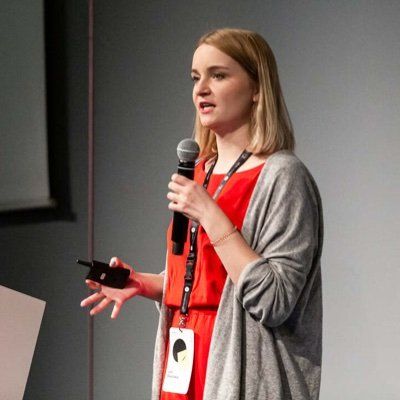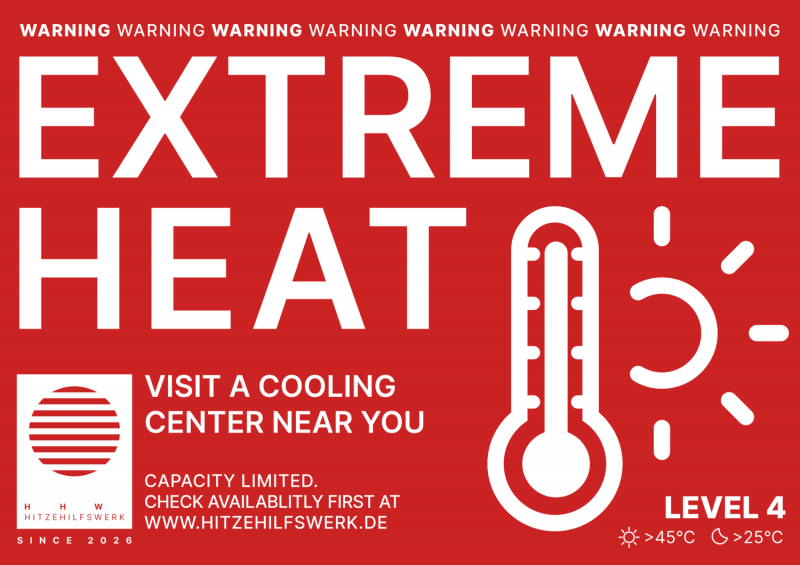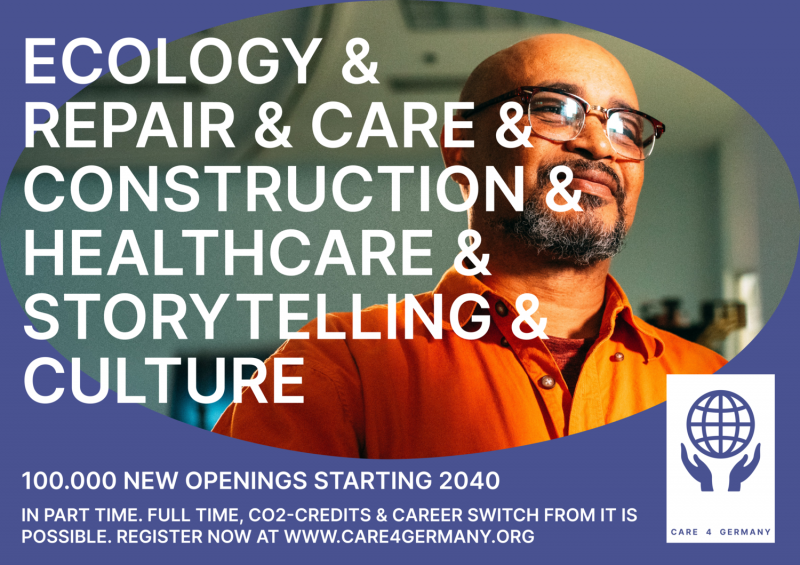
Juli Sikorska is a designer and a researcher. Originally in service design, she now focuses on systems, futures and the environment, in order to translate the uncertainties that are coming from the climate crisis into physical experiences. She mostly lives and works in Berlin.
Q: How did your project, “Urban Heat Island Living”, start and evolve?
When consulting with companies on how to make them more sustainable, I had the feeling that I would always get stuck by a lack of a tangible understanding of why it is so important to include a climate component. Right now, most of the information we receive, the goals that we set, are numbers, like tons of CO2, and it’s often far away, either geographically or in the future. I felt that until we manage to make this tangible, here and now, there would be no way to really transform the governments, the organizations, the companies that are creating the tissue of our world.
Around 2019, I started looking at heat in cities, because for a place like Munich or Berlin or most European cities, that’s the most direct effect of the climate crisis. I started looking at all of the little ways that heat is already changing Berlin, as well as projections dealing with climate scenarios to understand how a specific place may change in the future. I got a grant from [ngbK] to work on my neighborhood, Neukölln, to create a precise map-based experience of heat in the city, and make a group exhibition out of it. This is how Urban Heat Island Living was born.
Then, with another designer, Francesca Desmarais, who had run the Climate adaptation mission at the Copenhagen Institute for Interaction Design, we translated several climate scenarios into a physical experience. We looked at local data as well as weak signals to create a scenario of Berlin in 20 or 30 years from now.

Eventually, we built a world together. For this world we created posters that we put up in the city for over eight weeks, in July 2021. Together with that, we hosted a two days’ workshop where we invited people to play within the world with us: “Imagine it’s Berlin, 2039. It’s been 10 years since the massive heat waves that happened in Europe in the late ’20s. How did Berlin adapt? How did we deal with this initial intense series of heat waves? And then later, how do we create more resilience in the city?”
We rented this little chapel in the neighborhood; inside it was very cool, while outside it was a very hot week-end, and we had a summer thunderstorm. The workshop was a fantastic immersive experience that was built by the weather, and the chapel that we were in, and the worlds we had imagined, and the people who joined us to embody that world.
We then distilled it into a shorter format, the Heat Resilient Cities Conference. The conference format allows us to talk about a lot of different topics in a way where people get to have agency but don’t need to know everything, so they can talk with other people, have a little group work, etc. We wanted to develop that into an experience: something between a conference, a workshop and an immersive experience that people would be part of.
Q: Who runs the project, and how is it funded?
Francesca and I run the project when we can. It’s not an organization, nor a long-term program with its own funding.
Q: Who is generally involved in putting the project together?
Francesca and myself, then for each session we put a team together.
Q: When and where does it take place?
Mostly online since the pandemic, but we aim to go back to physical experiences.
Q: What publics do you work with, why, and what do they do together?
We work with organizations and teams whose mission is related to climate, environment, urban planning, human health. We figure out how it relates to their work and how the experience may be helpful for them. Then we take them through our experience, followed by a short debrief where we return from our future world, and try to translate that into a present-day context to understand how that affects them as organizations.
Q: In what ways do you work with arts, fiction and narrative?
It’s basically a narrative that we take people through. It has three key topics.
The first topic is heat adaptation. Imagine Berlin, or any other city in the future, experiencing more intense, more frequent, and longer heat waves. We talk about the super-hot subways, people dying, but that also spurs adaptation. So we put up the first cooling centers, then we create a network of them. We try to talk about how we adapt to extreme heat, we let people walk around this, create their own memories…
The second topic is the social and ecological transition, where we talk more about how the economy has also changed. We imagine this big Resilience Fund, groups that plant and water trees in the city, mushroom growers, nature artists creating green facades, etc. We imagine if we had little pockets of new cooperatives, new companies, forming to regenerate the city and create more resilience long term. And what if we had this public-jobs guarantee where everybody has the right to a meaningful job within that transition? We talk about what it would mean for a city to put social and climate-regenerating innovation really at the core of its economy.
The third topic is redefining care work, where we talk about care and its different place for people, for nature, for infrastructure, for culture.
For each of those topics, we have activities for people to project themselves into that world.
So we take them on this roller coaster ride where we first deal with this big crisis, find the very quick ways to deal with it, reactive responses, and then look at what are the proactive ways that we can work on at different levels or scales.

Q: What change(s) would you like the project to produce for the participants?
Geoff Mills, a creative writing coach we hired to help with our first workshop, wrote a really nice article, where he said that he’d never dealt with climate change before because it’s always been shouted at him. He knew that it’s important but it was still not something that he has found engaging. It wasn’t until the workshop that he realized how important it is. I have this wonderful quote where he says that, “Now I feel a need to act and the need to inspire others to do so, too.” I think that sums up my main objective.
We don’t want to tell people what they should do. Whenever we talk with businesses, they want to have an “outcome”. When we say, “it’s the physical, the visceral experiences you have on your body”, they tend to answer “Yes, but we want to have recommendations for how a city can adapt.” It’s not something that we do here. This is something that people themselves need to create afterwards, although we try to help during the debrief sessions.
Q: And beyond the participants (for a community, an organization, for the world…)?
A lot of people we have worked with want to stay involved, they want to do something. How is that going to become part of their own work?
Q: How do you know you have succeeded? Do you have evaluation methods?
We have a debrief at the end of each conference, where we try to understand how the experience was for people. The first question is whether they had an emotional connection, which is my main goal of doing this work. The second is how it could translate to their day-to-day work or life, whatever it is.
We have not formalized evaluation more than that. However, since the first conference, a few people have since then been sharing articles with me because they now look out for this. They now are more in tune with it, they pay attention.
Q: Have you formalized methods and/or tools? If so, are they accessible, open-source? Are you using pre-existing methods and/or tools?
Everybody who’s gone through the experience gets to use the materials: we make everything open source and available for everyone to create their own worlds and stories on top of it.
Q: Are there references you’d like to share (e.g., theoretical references, precedents, other projects that inspired you, etc.) ?
I have been very inspired by Transition Design as it comes from Carnegie Mellon, and by Experiential Futures from Stuart Candy. The very first work was inspired by the Extrapolation Factory and London’s School of Speculation.
More practical inspirations from other works that have been really influential are Stuart Candy’s US Earth Force, which was also a poster campaign; Mitigation of shock by Superflux; and Radical Ocean Futures, from the Stockholm Resiliency Center.
-
Project name
Urban Heat Island Living -
Description
“Since the historic extreme heat summer of 2029, we have been building urban resilience in Berlin and beyond to let all those who live in the city thrive – from the smallest inhabitants like microbes over humans to large-scale infrastructure. Since then, we’ve been responding to heat emergencies with Hitze-Hilfswerk, building strong ecosystems for carbon accounting and wildlife regeneration with Neukölln2040, and redefining care occupations with Germany’s first public job guarantee program Care4Germany.
We hosted the first Heat Resilient Cities Conference in Berlin-Neukölln in 2039 to review the transformation we crafted in the German capital, and foster exchange with other cities and invite new communities of knowledge to the conversation. Since then, we have hosted events in Helsinki/virtual, Amsterdam and Prague/virtual. We are always looking for citizen assemblies, municipalities, communities and organizations to host an event.”
Interview conducted by Daniel Kaplan
